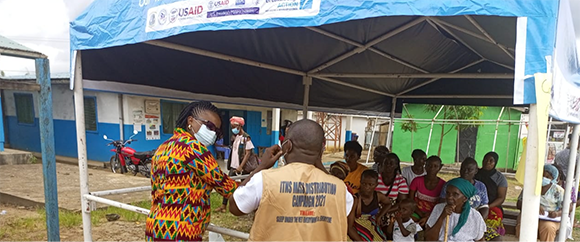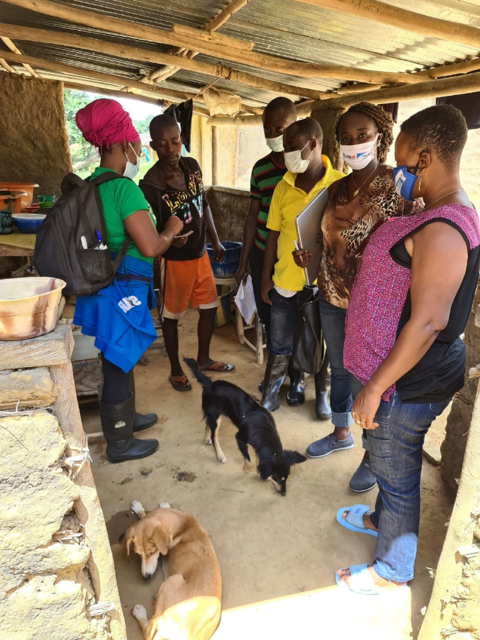Malaria continues to be one of the most dangerous diseases in the world, and the use of insecticide-treated mosquito nets (ITNs) continues to be one of the most effective ways of protecting people from the disease. ITNs are only effective if households believe in their efficacy to prevent malaria, and use them properly. One of the major setbacks to ITN distribution (whether via a mass campaign or through continuous distribution channels), ITN use, care and repair, is mis- or disinformation and rumours. If unchecked, these have the risk of eliminating any gains that countries may have made in reducing the malaria burden in their country.

Community sensitization during the ITN mass distribution.
Several countries distributing ITNs during the COVID-19 pandemic experienced outbreaks of rumours linking COVID-19 with the ITNs or the ITN campaign. However, rumours concerning malaria or ITNs were present well before the COVID-19 pandemic and have included claims such as:
- The efficacy of the ITN: “The ITNs don’t work and if you sleep under one it will make you sterile.”
- Culturally related rumours: “If the ITNs come from the (particular religious group), then it will make you convert to their religion.”
- Politically motivated disinformation: “The government is only distributing ITNs to get your vote.”
In July 2021, many counties in Liberia started reporting the emergence of rumours linking the ITN campaign with COVID-19. These rumours were created because the increase in COVID-19 cases during Liberia’s third wave coincided with the distribution of ITNs through the mass campaign. The scope and scale of these rumours varied greatly across counties, ranging from localized rumours that were quickly dispelled, to district level rumours that resulted in refusal to accept ITNs, misuse of ITNs and even in the destruction of ITNs.
Between 9—12 July 2021, the national malaria programme conducted a rapid assessment among county health teams (CHTs) to assess the scope and scale of the rumours affecting the ITN campaign. Rumours were identified from eight counties and were reported to affect an estimated 33 districts (out of a total of 54 districts). Three of the CHTs reported that the rumours had spread across the entire county. The rumours reflected negative perceptions of ITNs, including views that the ITNs are harmful, deadly and able to transmit COVID-19 to humans. The rumours in circulation also touched on issues related to production, access and use of the ITNs. Some specific rumours reported (organized under a central theme) included:
Rumours related to COVID-19
- The Ministry of Health (MoH) placed COVID-19 virus in the nets
- The MoH is distributing nets to increase the number of COVID-19 cases
- Health workers are placing COVID-19 virus in the nets
- The nets contain/are contaminated with/or are infected with the COVID-19 virus
- The net is what is causing Coronavirus and killing people
Rumours describing nets as harmful
- Since black people never died like the whites, they brought us nets so we can die
- The mosquito nets are killing people
- The nets have chemicals that will kill people to reduce the population
- These nets contain too much chemical, which is why they asked us to hang them outside before use
In general, the rumours had a very negative impact on the campaign and ITN use. A number of counties reported:
- Delays in ITN distribution related to the rumours as many households did not come to collect their nets from fixed distribution points.
- Financial implications of conducting mop-ups in their affected districts, especially if the mop-up required covering a large geographic area.
- ITNs being misused and in some extreme cases, being burnt.
The rapid assessment was not only to assess the scope and scale of the rumour, but also to help plan a response. This included a survey of the different communication channels that could be used to address the rumours. The social and behaviour change (SBC) activities or communication channels most frequently mentioned as best suited for the affected areas included community meetings and focus group discussions, community health volunteers (CHVs) and community health assistants (CHAs), town criers and motorized street announcements, as well as mass media such as local radio stations.

ITN use, care and repair demonstration during community sensitization session.
The rumours were identified during the actual implementation, when many CHTs had not yet undertaken planned SBC activities. Given the scope and scale of the rumours, it was critical that a response be immediate. Following brainstorming sessions with CHTs, a set of immediate actions were recommended to respond to the rumours:
At all levels, national malaria programme and CHTs, with support from partners:
- Continue SBC activities to promote proper use of the ITNs. Clarify the purpose, benefits and access to the nets for priority audiences (pregnant women, young children).
- Address rumours as part of the ongoing ITN promotion.
- Avoid further circulation of the rumours (do not repeat rumours in public fora).
- Share updated talking points to help ensure consistency in the key messages among all stakeholders.
- Capitalize on the evolving “good will” to promote the benefits and proper use of ITNs.
Community engagement (community and district level):
- Target districts where rumours are widespread.
- Engage local and religious leaders (those previously engaged and more) in affected districts through advocacy meetings and town hall gatherings to discuss rumours identified, provide the people with correct information and advocate for their support to address the rumours.
- Use testimonials from community members who are already properly using the ITNs to motivate peers through experience-sharing.
- Involve CHAs and CHVs in community-level health promotion efforts.
- Air remaining talk-shows to share accurate information about the ITNs, including benefits, proper preparation and proper use.
- Print and circulate existing posters on ITN use and antenatal (ANC) visits. Disseminate to target health facilities and communities.
- Increase use of publicity awareness-raising (i.e. motorized street announcement).
- Air jingles promoting ITN use on community radio stations.
- Monitor continuously for additional rumours and/or expansion of rumours to new areas of the county.
National level:
- Press release (from an influential government official) in support of ITN use, clearly outlining the benefits.
- Air jingles promoting ITN use on national radio stations.
 Several key lessons were learned in Liberia during this crisis. For SBC, none were more critical than the importance of having a strong rumour management plan that fully details the process for managing and responding to rumours. With support from technical partners, the national malaria programme had drafted a rumour management plan, but this was never finalized nor was it budgeted. This lack of available funding can create delays in the response to rumours, increasing the risk that rumours spread further and become unmanageable.
Several key lessons were learned in Liberia during this crisis. For SBC, none were more critical than the importance of having a strong rumour management plan that fully details the process for managing and responding to rumours. With support from technical partners, the national malaria programme had drafted a rumour management plan, but this was never finalized nor was it budgeted. This lack of available funding can create delays in the response to rumours, increasing the risk that rumours spread further and become unmanageable.
Going forward, it is critical that national malaria programmes ensure that robust and detailed rumour management plans are developed, that these are budgeted, are approved and adopted, and that the various components of the plan (including the roles and responsibilities of all stakeholders) are disseminated before the implementation of the campaign.
Drawing from the various lessons learned, AMP had developed a detailed guidance on the management of rumours and a template to guide the development of a rumour management plan as part of the macroplanning package. Please refer to the following link on the AMP website.
